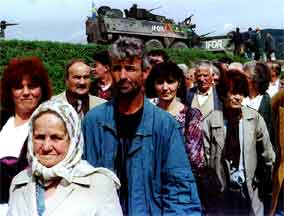1996 Elections in Bosnia
After several years of fighting and the deaths of tens of thousands, leaders of the battling forces met on November 1st at the Wright-Patterson Airforce Base, outside Dayton, Ohio, to negotiate a peace settlement. The Dayton Accords were initialed twenty days later, thus effectively bringing about a conditional end to armed hostilities. The accords were reinforced with 15,000 American ground troops, whose introduction assured that the ceasefire was observed by all sides. In an effort to construct a stable political system in the troubled region, elections were held on September 12, 1996; 60-70% of eligible voters cast votes, resulting in a three-headed presidency representing all the major ethnic groups..
As the situation in the Balkans deteriorated, the international community, led by the United States and the European Union, sought a diplomatic solution to the crisis. In September 1995, the US invited representatives from Bosnia and Herzegovina, Croatia, and Serbia to a secluded airbase near Dayton, Ohio, to negotiate a peace agreement. The talks were facilitated by US mediator Richard Holbrooke, with support from the European Union and Russia.
After 21 days of intense negotiations, the Dayton Accords were signed, outlining the framework for peace in Bosnia and Herzegovina. The Accords were a complex document, consisting of 11 annexes that addressed various aspects of the conflict. The main provisions of the agreement included:
-
The territorial division of Bosnia and Herzegovina into two entities: the Federation of Bosnia and Herzegovina (with a majority Bosniak and Croat population) and the Republika Srpska (with a majority Serb population). The central government was granted limited powers, while the entities were provided with substantial autonomy.
-
The establishment of a rotating presidency, with one representative from each of the three major ethnic groups (Bosniaks, Serbs, and Croats).
-
The creation of a new constitution, which guaranteed the protection of human rights and the rights of ethnic and religious groups.
-
The establishment of an international peacekeeping force, known as the Implementation Force (IFOR), later succeeded by the Stabilization Force (SFOR), tasked with maintaining peace and security in Bosnia and Herzegovina.
-
The commitment to the return of refugees and displaced persons to their pre-war homes and the right to compensation for lost property.
-
The establishment of a war crimes tribunal, known as the International Criminal Tribunal for the Former Yugoslavia (ICTY), to prosecute those responsible for war crimes, crimes against humanity, and genocide during the conflict.
Impact and Legacy
The Dayton Accords brought an end to the devastating Bosnian War and provided a framework for peace and stability in the region.The next step in the process were helding elections in Bosnia. The elections were held on September 14, 1996, under the supervision of the Organization for Security and Co-operation in Europe (OSCE), which was responsible for organizing and monitoring the electoral process. The elections were held for several levels of government, including the Presidency, the House of Representatives of Bosnia and Herzegovina, the two entity parliaments (the National Assembly of Republika Srpska and the House of Representatives of the Federation of Bosnia and Herzegovina), and the cantonal assemblies in the Federation of Bosnia and Herzegovina.
The results of the elections were largely dominated by nationalist parties representing the three main ethnic groups – Bosniaks, Croats, and Serbs. In the Presidency, the three members were elected as follows: Alija Izetbegović, representing the Party of Democratic Action (SDA), was elected as the Bosniak member; Kresimir Zubak, representing the Croatian Democratic Union of Bosnia and Herzegovina (HDZ BiH), was elected as the Croat member; and Momčilo Krajišnik, representing the Serb Democratic Party (SDS), was elected as the Serb member.
 >
>